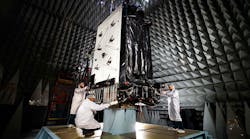The U.S. Air Force has opened a review of the propulsion systems used for Lockheed Martin Corp.’s (IW 500/25) military satellites after an undisclosed problem during a recent attempt to boost one into orbit, according to the service.
The review has delayed once again the Air Force’s acceptance of Lockheed’s first new Global Positioning System satellite, which is already 34 months late. The most recent delivery goal had been Feb. 28, and the plan remains to launch it by spring of 2018.
While there’s no evidence that the propulsion system on the first, $528 million satellite in the new GPS III series has a flaw, the Air Force has decided to keep it in storage at a Lockheed facility “out of an abundance of caution,” Captain AnnMarie Annicelli, an Air Force spokeswoman, said in an email. It was placed into storage “after having successfully completed all planned test and integration activities,” she said.
The review of Lockheed’s A2100 propulsion subsystem involves the GPS III -- an improved version of the navigation systems used by the military and civilians worldwide -- as well as the company’s Advanced Extremely-High Frequency communication satellite and its Space Based Infrared early warning satellite, Annicelli said. Matt Kramer, a spokesman for Lockheed’s space systems unit, said in an email “more than 50 Lockheed Martin A2100 bus satellites are operating successfully on orbit.”
The Air Force and Lockheed Martin “are thoroughly evaluating” the GPS III’s A2100 system prior to declaring the satellite available for launch, Kramer said. “This review is a standard process for our rigorous systems engineering approach to assure mission success” as the company “is working closely with the Air Force on resolving any concerns about the mission readiness of” the satellite’s propulsion system, he said.
The review is focused on operations that boost into proper orbit military satellites that use the contractor’s A2100 system, Annicelli said, declining to provide additional details. Satellites boost themselves into a designated orbit using on-board propulsion systems in what’s called a “transfer orbit operation.”
Subsystem Performance Evaluation
“This review will assure” that the first GPS III satellite is ready to launch next year, she said. The Air Force’s Space and Missile Systems Center “is currently evaluating subsystem performance" across the three Lockheed satellite programs, she said. “It is not possible to give a definite prediction on how long it will take" to finish the review, she said.
The GPS III satellite is far behind its original delivery schedule because of technical flaws, first with its navigation payloads and later with ceramic capacitors, which take higher-voltage power from the satellite’s power system and reduce it to a voltage required for a particular subsystem.
Most recently, a mistake by subcontractor Harris Corp. in testing forced another delay in the delivery on the first of the 32 planned GPS III satellites.
Might Satellite Competition Reopen?
Lockheed has a contract to build the first 10 of the satellites. But the program’s setbacks, including the new review, may affect a pending Air Force decision on whether to open the final 22 satellites to competition from Lockheed rivals Boeing Co. and Northrop Grumman Corp.
The Defense Contract Management Agency estimates that the second through eighth satellites that Lockheed is building will be delivered six months to one year later than the Air Force’s schedule, spokesman Mark Woodbury in an email.
The Air Force estimates the second satellite will be delivered in February 2018, while the contract agency projects August 2018. The third is scheduled for August 2018 delivery, but the agency says it will be March 2019. The fourth is scheduled for January 2019 by the Air Force and for August 2019 by the agency. The seventh is scheduled for February 2020, but the agency predicts January 2021. The eighth is scheduled for May 2020, while the agency forecasts June 2021.
The agency’s dates “are based on a conservative confidence level” while Lockheed is “managing to a more aggressive schedule” and that anticipated deliveries will improve as more lessons are learned in manufacturing, Woodbury said.
The difference between the Air Force and agency “is due to different forecasting approaches,” Annicelli said.
By Tony Capaccio



